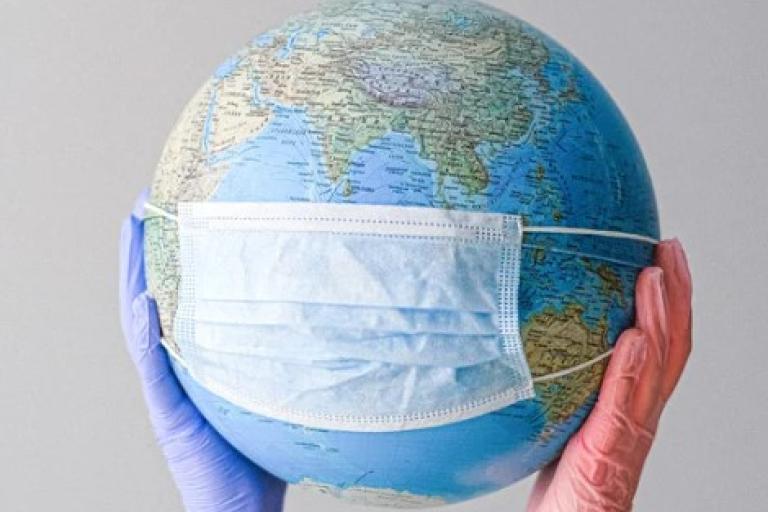WMO COVID-19 Research Task Team issues recommendations
Lessons learned and experience gained about the interplay between Meteorological and Air Quality Factors and COVID-19 can serve as a blueprint for informing global responses to future public health emergencies and pandemics, a World Meteorological Organization (WMO) Task Team has concluded.

Lessons learned and experience gained about the interplay between Meteorological and Air Quality Factors and COVID-19 can serve as a blueprint for informing global responses to future public health emergencies and pandemics, a World Meteorological Organization (WMO) Task Team has concluded.
During the COVID-19 pandemic, many National Meteorological and Hydrological Services (NMHS) sought to provide useful and actionable information to help understand and manage the pandemic and related decision-support. Given that little was known about the influence of environmental factors on disease transmission, at the beginning of the pandemic WMO created a COVID-19 Research Task Team on appropriate use of meteorological, climate and air quality information for COVID-19. The existing joint programming between the World Health Organization and WMO helped rapidly establish the collaboration between global meteorological and health experts.
The Research Task Team has now issued recommendations providing an overview of knowledge, reflections and lessons learned. It is designed to provide advice to NMHS regarding the provision of services for COVID-19, given that the WMO community can provide useful information to support the health sector during a pandemic, or localized outbreaks and public health emergencies.
It updates the current state of understanding of meteorological and air quality (MAQ) affecting SARS-COV-2 transmission and COVID-19 severity from the First Report of the WMO COVID-19 Task Team | E-Library, in particular referring to questions about Seasonality, Air Quality and Compound Hazards.
The recommendations were issued during the annual session of WMO’s Executive Council, which has a focus on the strengthening of weather, climate, water and environmental services to serve the needs of society.
Scientific Knowledge

The influence of meteorological and air quality (MAQ) drivers on SARS-CoV-2 transmission and COVID-19 severity remains an active research topic. But it appears that other factors, including vaccine coverage, new variants, government interventions and personal protection measures and behaviours, are the major drivers.
However, MAQ information can be used effectively to design and execute COVID-19-related interventions, e.g. for the logistics of vaccine handling, implementing adequate ventilation of, or air filtration in, indoor spaces, establishment of field hospitals, and management of compound environmental hazards.
Seasonality: The transmission of some respiratory viruses vary seasonally, including influenza and other human coronaviruses, with outbreaks generally occurring during winter months in temperate zones. There is emerging evidence that SARSCoV-2 transmission may be favoured under wintertime conditions in temperate regions, due to greater concentration of people in less well-ventilated indoor areas. However, one cannot assume reduction in risk during warm seasons, as other factors can dominate the seasonal influence on overall risk profiles.
Air Quality: A number of epidemiological studies have suggested that long-term exposure to air pollutants, including particulate matter (PM), ozone (O3), and nitrogen dioxide (NO2), is associated with more severe COVID-19 symptoms and higher likelihood of death. Evidence regarding the influence of short-term air pollution exposure to COVID-19 risk is still emerging.
Compound Hazards: The COVID-19 pandemic combined with weather and climate risks to create multiple major compound hazard events that challenged local authorities to adhere to disease prevention protocols, while managing extreme weather events. Examples include cyclones and hurricanes that necessitated large-scale evacuations, floods that displaced people into temporary housing, and extreme heat events that forced some to find shared climate-controlled environments. Meteorological services have a leading role to play in preparedness for and response to such compound hazard events.
The way forward
“The positive global response to the pandemic has been underpinned by an unprecedented and unrestricted access to data sets previously unavailable on a routine basis. Such access must continue to ensure that current and future interventions and cross-cutting services can depend on these vital data to help address challenges,” says the briefing note.
The scramble for data and information exchange at the outset of the pandemic emphasizes the need to establish long-term collaboration between the weather, climate and environmental services and public health communities, including academics, practitioners, policymakers and funders. There should be clear corresponding roles and ownership to support critical public health research and response.
The Task Team recommended clear documentation and regular updating of datasets, methods and frameworks for risk assessment. Co-developed integrated climate and disease surveillance systems or observatories can support the effective use of climate science and services in the context of emergencies. Managing expectations and responsibly applying emerging understanding considering a balance of timeliness versus uncertainty is key to address current and future emerging public health threats.
“The experience of COVID-19 highlights the need to build on past experience and to address this challenge in appropriate context as new threats emerge,” it says.
The COVID-19 Research Task Team briefing note is available here
Additional activities on health, including the Task Team can be found here: Health | World Meteorological Organization (wmo.int)










